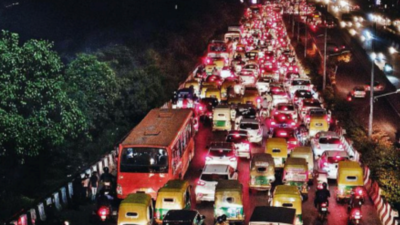Top Searches
- News
- City News
- delhi News
- Delhi: Vehicle emissions largest source of pollution in Diwali week, says CSE
Delhi: Vehicle emissions largest source of pollution in Diwali week, says CSE

The city’s vehicles accounted for nearly 17% of the total PM2.5, the CSE study said
NEW DELHI: Vehicles in Delhi were the largest local source of pollution this year during Diwali week, an assessment by Centre for Science and Environment (CSE) has revealed.
According to CSE, vehicles accounted for almost half of Delhi's own contribution to PM2.5 concentration between October 21 and 26. However, taking pollution concentration from all sources, including Delhi's local sources, the NCR and beyond, the city's vehicles accounted for nearly 17% of the total PM2.5, the study said.
Track the pollution level in your city
Long congestion of traffic from noon to 8pm during Diwali lowered the average speed from 60 kmph to 27 kmph and, on some stretches, to even 17 kmph, leading to high emissions, including nitrogen dioxide. This shortened the gap between peak and non-peak hours of pollution.
"The city, with 1.4 crore registered vehicles and an annual addition of five lakh, of which 97% are personal two-wheelers and cars, has failed to build transportation strategies to scale for transformative changes. With a population of over 2 crore, the city is estimated to be generating at least 276 lakh daily travel trips. If most of these trips have to be self-organised with personal vehicles, Delhi cannot meet the clean air target or the benchmarks for liveability," said Anumita Roychowdhury, executive director, research and advocacy, CSE.
The report called out GT Karnal Road and Guru Ravidas Marg as the congestion hotspots where average speed of traffic was 17 kmph.
"Taken together with other sources, such as biomass and pollution from NCR and other districts, vehicles contributed to nearly 17% of the total PM2.5. But if only Delhi's local sources are considered, the transport sector topped the ranks with vehicles contributing around half of the PM2.5 concentration. The indicative data shows their daily share varied between 49.3% and 53% during that week," said the report.
Vehicular emissions were followed by household pollution at 13%, industries 11%, C&D 7%, waste burning and the energy sector at 5% each, and road dust and other sources at 4% each. "This observation is consistent with the trends evaluated during the previous winter," said Vivek Chattopadhyay, principal programme manager with CSE's Clean Air and Sustainable Mobility unit.
The analysis stressed on measures like better public transport, electrification of fleets, walking and cycling infrastructure, low-emission zones, vehicle restraint measures, like parking caps and pricing, etc.
It suggested increasing and improving the service quality of buses, stating that while the numbers were increasing, they were still not enough. "Delhi, with 7,320 buses currently, has close to 37 buses per lakh of population against the recommended 60," stated the report, suggesting better integration of buses and Delhi Metro.
It also urged to scale up walking and cycling infrastructure to connect neighbourhoods and to promote low-emission zones linked to electric vehicles.
According to CSE, vehicles accounted for almost half of Delhi's own contribution to PM2.5 concentration between October 21 and 26. However, taking pollution concentration from all sources, including Delhi's local sources, the NCR and beyond, the city's vehicles accounted for nearly 17% of the total PM2.5, the study said.
Track the pollution level in your city
Long congestion of traffic from noon to 8pm during Diwali lowered the average speed from 60 kmph to 27 kmph and, on some stretches, to even 17 kmph, leading to high emissions, including nitrogen dioxide. This shortened the gap between peak and non-peak hours of pollution.
"The city, with 1.4 crore registered vehicles and an annual addition of five lakh, of which 97% are personal two-wheelers and cars, has failed to build transportation strategies to scale for transformative changes. With a population of over 2 crore, the city is estimated to be generating at least 276 lakh daily travel trips. If most of these trips have to be self-organised with personal vehicles, Delhi cannot meet the clean air target or the benchmarks for liveability," said Anumita Roychowdhury, executive director, research and advocacy, CSE.
The report called out GT Karnal Road and Guru Ravidas Marg as the congestion hotspots where average speed of traffic was 17 kmph.
"Taken together with other sources, such as biomass and pollution from NCR and other districts, vehicles contributed to nearly 17% of the total PM2.5. But if only Delhi's local sources are considered, the transport sector topped the ranks with vehicles contributing around half of the PM2.5 concentration. The indicative data shows their daily share varied between 49.3% and 53% during that week," said the report.
Vehicular emissions were followed by household pollution at 13%, industries 11%, C&D 7%, waste burning and the energy sector at 5% each, and road dust and other sources at 4% each. "This observation is consistent with the trends evaluated during the previous winter," said Vivek Chattopadhyay, principal programme manager with CSE's Clean Air and Sustainable Mobility unit.
The analysis stressed on measures like better public transport, electrification of fleets, walking and cycling infrastructure, low-emission zones, vehicle restraint measures, like parking caps and pricing, etc.
It suggested increasing and improving the service quality of buses, stating that while the numbers were increasing, they were still not enough. "Delhi, with 7,320 buses currently, has close to 37 buses per lakh of population against the recommended 60," stated the report, suggesting better integration of buses and Delhi Metro.
It also urged to scale up walking and cycling infrastructure to connect neighbourhoods and to promote low-emission zones linked to electric vehicles.
FOLLOW US ON SOCIAL MEDIA
FacebookTwitterInstagramKOO APPYOUTUBE
Start a Conversation
end of article









